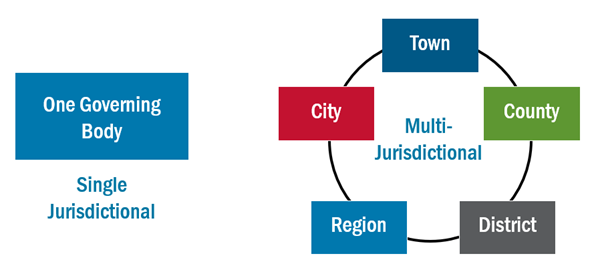1.1.1. New Plan or Plan Update
Once you decide to create a hazard mitigation plan, it’s time to set up the planning process. The foundation of all mitigation plans is an inclusive, well-documented planning process with community buy-in. A successful process brings diverse partners together. They will discuss your community’s experience with natural hazards and how to meet your risk reduction needs.
The first question that needs to be answered when developing a mitigation plan is: Are you updating a plan or creating a new one? There are instances where participants in a multi-jurisdictional plan decide to create their own plan, resulting in a “new” plan. Additionally, single jurisdictions may see the value of participating in an existing regional plan that is being updated. All local situations are unique and deciding on the type of plan to develop will depend on the needs of the local community.
1.1.2. Confirm Participant(s) and Planning Area
Plans can be single- or multi-jurisdictional. Multi-jurisdictional plans require all participants to meet certain requirements to adopt. Multi-jurisdictional plans may include local and tribal governments, and special districts.
Communities may choose to develop their own plan or work with other communities. No matter the configuration, all participants must meet the mitigation planning requirements.

Both single- and multi-jurisdictional plans have benefits and challenges. Single-jurisdiction plans offer independence in how the community will design and conduct its planning process. This type of plan can be suitable for any community, large or small.
Multi-jurisdictional plans have certain requirements that help to make sure each community goes through its own local planning process, in addition to the overall group effort. The group planning process will be led by the coordinating entity, referred to as the plan owner, and will include representatives from each jurisdiction. The plan owner takes the lead for coordinating across all participants and with the state and FEMA. Each jurisdiction will take the information shared at group meetings, pass the information on, and collect information through their own local planning process. Each participant must assess their unique risk to identified hazards and identify their own capabilities to reduce those risks. Each must develop their own actions to reduce the risks specific to their community.
Benefits and Challenges of Multi-Jurisdictional Plans
Benefits of a Multi-Jurisdictional Plan
- Improves communication and coordination.
- Enables comprehensive and regional mitigation approaches.
- Maximizes economies of scale by sharing costs and capabilities.
- Avoids duplication of effort.
- Provides organizational structure.
- Broader chances for participation.
Challenges of a Multi-Jurisdictional Plan
- Reduces individual control over the process.
- Involves coordination and administration to track multiple independent local governments, especially when it comes time for each local government to adopt the plan.
- Requires organizing large amounts of information, including individualized mitigation strategies, into a single document.
If you find that a multi-jurisdictional planning effort is the best option for your community, then decide if it is best to join an existing planning effort or take the lead on initiating a multi-jurisdictional plan. Plan owners for multi-jurisdictional plans typically include counties, rural or metropolitan planning organizations and planning districts. Multi-jurisdictional planning works best when jurisdictions:
- Share boundaries and have economic ties (workplaces and workforce housing, transportation, critical infrastructure, etc.).
- Face similar threats or hazards.
- Work under the same authorities.
- Have similar needs and capabilities.
- Have worked well together in the past.
You will need to partner with neighboring jurisdictions that could be Tribal governments and/or quasi-governmental agencies. These may include special districts that own and operate critical infrastructure or that would like to apply for FEMA mitigation project grants. Special districts have an interest in reducing threats and hazard impacts as many serve customers across multiple jurisdictions. This is especially true if they provide services that are vital to recovery efforts.
The planning area refers to the geographic area the plan covers. Generally, the planning area follows jurisdictional boundaries. These can include cities, townships, counties and planning districts. However, watersheds or other natural features may also define planning areas. Communities may choose this approach when hazards create similar risks across jurisdictional boundaries.
The State Hazard Mitigation Officer (SHMO) or state emergency management agency can help communities determine the appropriate planning area, too. State planning goals and funding priorities may guide this decision. Keep in mind that the scale of the planning area should be meaningful to participants to form an enduring resilience framework. For example, consider aligning with established regional planning or economic development districts to leverage their planning expertise.
After identifying the planning area and participating jurisdictions, it helps to get a written commitment from all participants. Ask the jurisdictions to sign a Voluntary Participation Agreement (VPA) at the start of the planning process. The VPA should outline requirements for each participating jurisdiction. You can find a sample VPA for a multi-jurisdictional planning team in Annex B.
1.1.3. Review Previous Plan and Scope Update
If you are updating your mitigation plan, read your community’s previously approved plan and the Plan Review Tool (PRT). The plan is a baseline for understanding and updating hazards, risks and community profiles. It can help you identify opportunities for improvement. Reading the previously approved plan can also aid in identifying areas that may need more time and resources.
If you have a previously approved plan, FEMA completed Section 2 of the PRT during their review process. It notes plan strengths and identifies opportunities for improvement. Let this guide your priority areas for the plan update. Incorporating FEMA’s feedback can help you improve each subsequent version of a plan.


